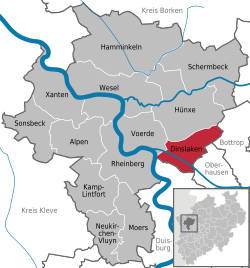Dinslaken
| Dinslaken | |||
|---|---|---|---|
|
|||
| Coordinates: 51°34′N 6°44′E / 51.567°N 6.733°ECoordinates: 51°34′N 6°44′E / 51.567°N 6.733°E | |||
| Country | Germany | ||
| State | North Rhine-Westphalia | ||
| Admin. region | Düsseldorf | ||
| District | Wesel | ||
| Government | |||
| • Mayor | Michael Heidinger (SPD) | ||
| Area | |||
| • Total | 47.67 km2 (18.41 sq mi) | ||
| Elevation | 20 - 113 m (−351 ft) | ||
| Population (2015-12-31) | |||
| • Total | 67,452 | ||
| • Density | 1,400/km2 (3,700/sq mi) | ||
| Time zone | CET/CEST (UTC+1/+2) | ||
| Postal codes | 46535, 46537, 46539 | ||
| Dialling codes | 02064 | ||
| Vehicle registration | WES, DIN, MO | ||
| Website | www.dinslaken.de | ||
Dinslaken is a town in the district of Wesel, in North Rhine-Westphalia, Germany. It is known for its harness racing track, its now closed coal mine in Lohberg and its wealthy neighborhoods Hiesfeld and Eppinghoven.
Dinslaken is a city of the Lower Rhine region and situated at the northwestern margin of the Ruhr area, approx. 15 kilometres (9 miles) north of Duisburg.
Dinslaken consists of 7 subdivisions
The medieval parish church, St. Vincentius, was heavily damaged during World War II, but was rebuilt from 1951 to 1952.
Dinslaken's twin towns include:
...
Wikipedia




